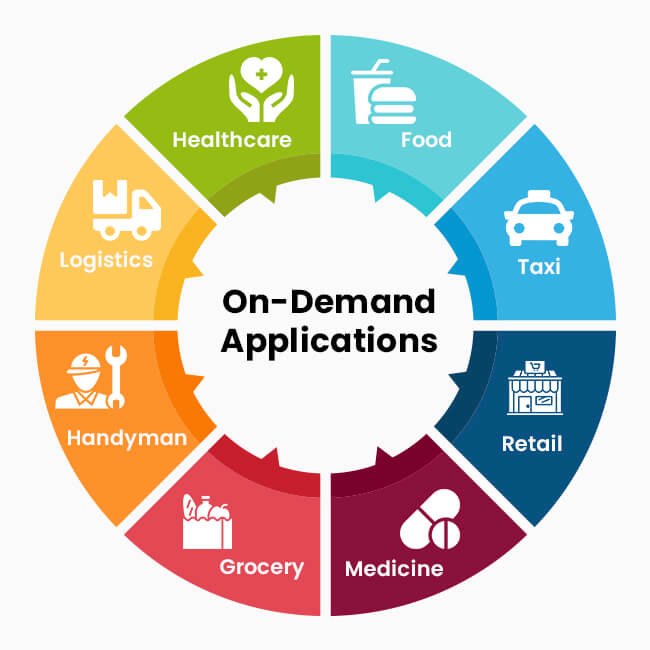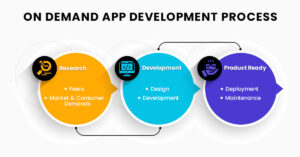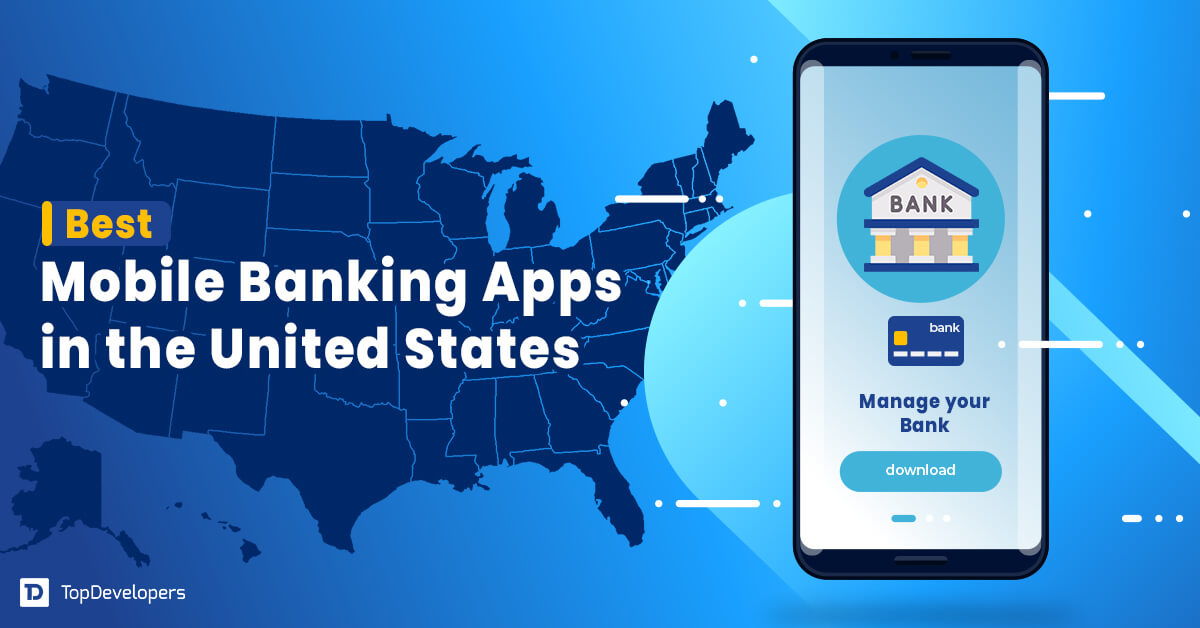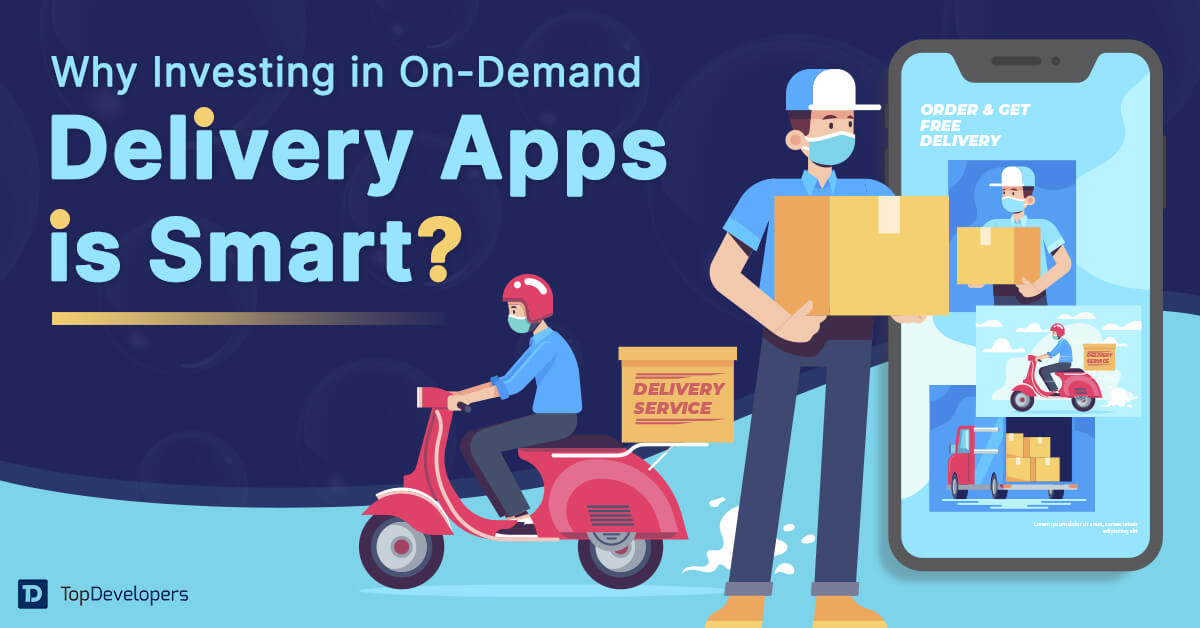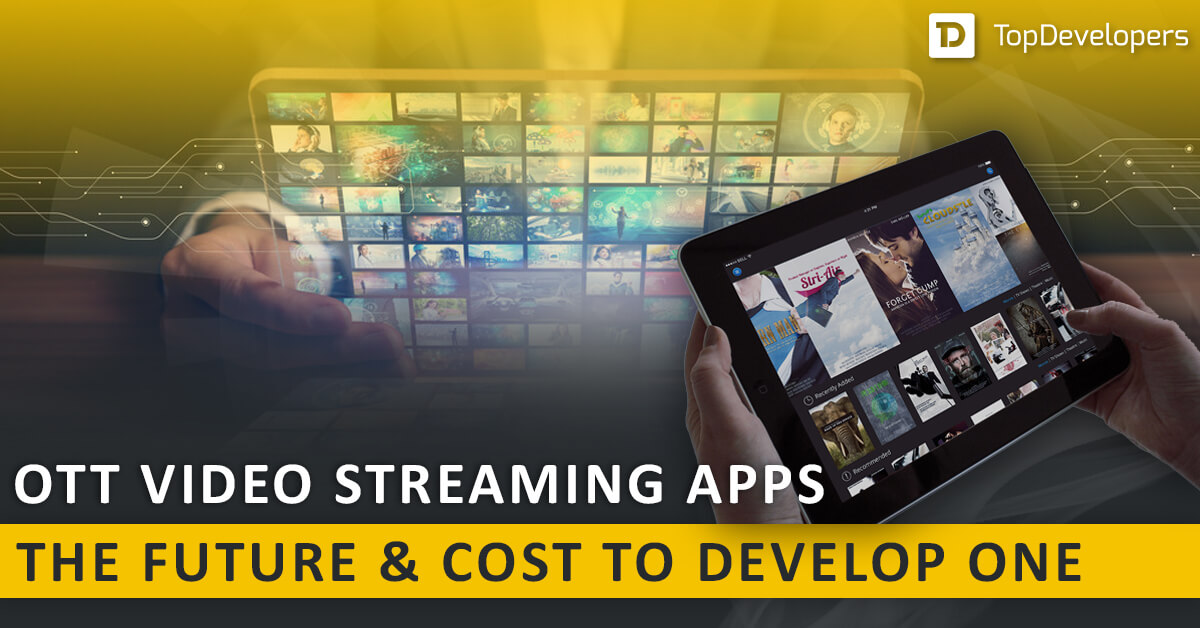
According to GlobalNewsWire, the on-demand food delivery market is likely to touch USD 160 billion by 2023. Furthermore, the on-demand labor market is supposed to grow nearly 20% annually in the coming years.
While these are a few validatory stats, there are many astonishing figures that prove how on-demand mobile app development for startups and established businesses are setting milestones in the international digital market. Netflix and Uber have shown a way for angel investors and young entrepreneurs to think out of the box. Such thought process makes it a necessity for the business to find the best mobile app development company based on your business needs.
Once just intended as ride-sharing on-demand mobile apps today have grown into multipurpose 360-degree applications that cater to almost all market segments ranging from grocery delivery, food delivery, cosmetics, medicines, laundry, and even instant home services.
Today, the online market is largely driven by mobile app development companies specializing in on-demand app-making.
Table of Contents
- How ‘On-Demand Economy’ is impacting Business World?
- Types of on-demand service mobile apps
- What are the Two main on-demand business models to consider?
- What are the top two factors to focus on for my on-demand app development?
- On-demand service app features
- What is the process of developing on demand apps?
- How much does it cost to develop an on-demand app?
- The demand for On-Demand App!
How ‘On-Demand Economy’ is impacting Business World?
The market of on-demand service app development is at its peak due to enormous demand in all industry verticals and all across the world. Investors have been putting zillions of dollars into this industry as in most cases, success is guaranteed. A report quotes that on-demand users spend an average of USD 57.6 billion annually wherein the online marketplace contributes the major factor.
Adding icing on the cake, the supply chain and communication technologies have boosted the on-demand industry economy manifold. Consumer demand and market actions ask for industries and services on a standby mode to serve them instantly whenever they want any products or services. According to one of the PwC reports, the market of on-demand mobile apps and portals would witness a significant worth of over USD 300 billion by the end of 2025.
Since most markets, today, are driven by on-demand services and deliveries, many entrepreneurs intend to build an app that focuses on providing users with an all-in-all solution so that they can use a single mobile application to order most products and services to get delivered to their doorsteps.
Types of on-demand service mobile apps
There are many different types of on-demand mobile apps depending on which the on demand app development company includes design features and business flow.
On-demand food delivery applications
This is one of the fastest-growing on-demand services in developing and developed countries. Over the past few years, especially pandemic where restaurants were not allowed to offer dine-in option, online food delivery applications grew like mushrooms in the rains. The trend continued as a part of people’s habit to order food with minimal human touch. Multiple business options are available for on-demand food delivery mobile apps.
In another aspect, market experts opine that most app development outsourcing for on-demand delivery service apps is the project for the food delivery business. Some of the best on-demand food delivery apps include Seamless, Grubhub, Foodpanda, UberEats, Postmates, EAT 24, DoorDash, Swiggy, and so on. Several app development methodologies have been used to make these applications an omnipotent place where users can order anything. The use of contemporary technologies allows users to view the dishes, rate the café, eateries or restaurants, and even perform various other activities on the apps.
On-demand grocery delivery
This is another already popular on-demand service popular on Google play store and Apple’s app stores. On demand grocery delivery apps for instant delivery at buyers’ doorsteps have been in immense demand since the world was hit by the unprecedented pandemic. If you’re looking to take advantage of this growing trend and bring your own grocery delivery app to life, exploring the business models, revenue models and features of grocery delivery app development could be a game-changer for your business. While the same-day delivery option is getting old, people are quite curious to adopt the 10-minute delivery application that wonderfully delivers all sorts of goods and materials within the said time. Zepto and Blinkit are a couple of examples that have found places on people’s mobile phones for quick delivery of the goods.
Handyman as on-demand app services
The demand for having a handyman on a standby mode has been increasing like never before. From a simple plumbing job to fixing a wooden door to landscaping the backyard or coloring the fence, all trivial jobs have been quite a headache, especially for those who work in the daytime. An all-rounder on-demand home service application that offers all such services by experts from the nearby vicinity has been in great demand, especially in the western world countries.
On-demand cab or taxi services
Instant taxi or cab services such as Uber and Ola have set an example for the best app monetization due to which global entrepreneurs have started to hire remote developers for on-demand mobile software.
The revenue model for such applications is so alluring that even multi-national companies are aiming to invest heavily in on-demand taxi booking app development to expand their businesses.
Like other applications, on-demand booking service for cab and taxi has also evolved from its basic features and today it includes carpooling, car rental, and even goods delivery applications within the app.
On-demand delivery of medicines
Post-pandemic, the demand for visiting pharmacies to buy medicines has markedly plummeted. Instead, on-demand medicine delivery services have skyrocketed due to their myriad benefits – contactless (so fewer chances of infection), instant deliveries (so that the medicines can be used urgently), digital payment (again no contact plus no need to pay in cash), and many more.
According to Statista, the revenue of the online pharmacy market is likely to reach a CAGR of more than 11% and touch a whopping USD 35 billion by 2026. It is on-demand medicine delivery app development. As with other on-demand apps are evolving and updating with new features and functionalities, online drug delivery system has also extended their services and features as the business model.
Now, not only do they offer delivery of medicine at your doorstep but also include online healthcare professionals’ consultations, health tips, and paid dietary regimens with many other health and fitness-related services.
On demand Logistics services
Due to significant demand in online shopping and world trade, the need of logistics has increased manifold. Hence, on-demand logistics apps could be one of the lucrative businesses for entrepreneurs.
The app may contain the following services –
- Transportation and logistics search
- Comparison of freight prices
- Availability of drivers, pilots, and captains
- Cargo consignment locations
- Live location and tracking of shipment
On demand Healthcare business
Post-pandemic, the health consciousness among people has awakened. Today, 6 out of 10 urban dwellers are likely to take healthcare services in one or the other ways. On-demand healthcare services can be thought to include in-app services. And there are many healthcare app ideas that startups can follow. Such services may include following features –
- Search and filter healthcare providers (physiotherapists, physicians, alternative medicine experts, and so on)
- Health counselor on demand
- Yoga and massage instructor and performer
- Medicine delivery
- Fitness personal trainers on demand
- Nurse and caretaker search and availability
- Emergency services (such as calling an ambulance)
- Diet and Nutrition Tracking
- Doctor Appointment Booking System
- On-Demand Medical App For Real-Time Diagnosis
On-demand retail apps
Retail on-demand mobile app services include several items chiefly merchandise and clothing. A few entrepreneurs also include their superstores to offer a gamut of goods and materials to purchase from their online retail business.
Extending its features further, some platforms offer contactless deliveries and instant services as a part of the retail delivery business. However, if one is not confident about what to include, they can take the help of a top mobile app development service provider and work on MVP development and then take their projects further as per the needs of the final users or buyers.
According to Walker Sands, 54% of US citizens (under 25) opt for same-day delivery applications for online purchases. The short-time delivery option increases the user base that are in hurry to get their products.
With improved logistics and the technologies such as Artificial Intelligence (AI), Augmented Reality (AR), Virtual reality (VR), and the Internet of Things (IoT), this sector is likely to get another boom in near future.
What are the Two main on-demand business models to consider?
Chiefly, there are two types of on-demand business models where one focuses on providing a particular service from a particular vendor or business owner, and the other type includes providing a larger platform where several other vendors and business owners are allowed to register and portray their services and products.
On-demand app
In an on-demand app business model, the services are provided by one vendor (or a business owner) where they offer several types of products or services to customers or users as and when they want. For instance, an on-demand grocery app would provide hundreds of products to consumers; the users can order any grocery item (say, cookies or bread) on the app and the vendors shall deliver it at users’ doorsteps.
On-demand marketplace app
This type of business is a broader category of the previous model. Here, a larger platform is created where vendors are invited to list their products and provide services. Not restricted to one business or business owner, such a marketplace app serves as a super app where users can find almost everything they want. The app owners are not necessarily business owners or vendors themselves.
What are the top two factors to focus on for my on-demand app development?
As a business person, you might have studied similar on-demand service apps to have the best app features in your product; nevertheless, if you miss the two most important factors before you contact IT service provider to build your mobile app, you are likely to face many challenges post-launch. Here are those two crucial factors to mind –
Picking the target audience or end users
While creating a Business plan for your mobile app idea you should do a thorough market analysis that segregates target audiences or end users because it will make a big difference in building features of your on-demand mobile app. Picking up the wrong choice would end up in a failure as the apps would not prove themselves in user experience due to misunderstood user demands and the latest trends in mobile app development.
The target audience could be anyone -from office goers to homemakers, and businesspersons to night owls. It could be specified by gender, age, and even ethnicity.
Identifying the gray area that is common yet unexplored
After the segmentation of end users, the next step is to identify the common issue, or problem, concerning them. Grabbing an opportunity depends on the market trend or societal situation -for instance, the pandemic brought enormous opportunities to on-demand medicine and food delivery businesses.
In metro cities, mobile apps for cab or taxi services are in the rage, especially where public transport is weaker. Night owls who burn midnight oils almost every day would be allured to night-delivery food applications. Entrepreneurs who invest in on-demand delivery apps after such research and studies are likely to reach their break-even point faster.
On-demand service app features
The features of on-demand service applications depend on the types of their users. The feature of each mobile software or web app would cater to the needs of the users. Through customized app development methodologies, the features are tailored to the users’ needs and so the privileges are also granted accordingly. Here are the different user panels and their features for on-demand service apps –
App features to have in Customer panel
The customers or end users (target audiences) would be at the core of on-demand mobile app features. It is because they are the ones who would make the app either hit or flop!
Here are some of the common features you can include during on-demand app development.
- Push notification
- Tracking ordered items real-time
- Payment gateway
- Reviews and ratings
- Favorites
- Help and support
App features to include in Service provider panel
After users, the features of the service provider panel are determined to provide enough power and privilege to maintain the products and services on the on demand application.
The on-demand service provider panel would have following general features to start with –
- Push notification
- Managing requests
- Start, end, or edit services and/or products
- Track business
- Analytics
App features to have in Admin panel
Administrator or admin is the main user who would have all privileges and power to edit, add, delete, or remove any user or stakeholder. The admin’s panel on the on-demand app shall have everything that can help anyone control the entire software through a few clicks.
- All-in-one dashboard
- All user profile management
- Master analytics and reports
The features can also be divided from the perspective of their general functionalities as found on any common mobile application.
Here are they –
- Register or sign in (through various methods including social media, email, and phone number)
- Manage profile (add, edit, remove content)
- Search and filter (according to your preference – for example – fastest grocery delivery in my area)
- Order history and favorite vendors (for quick ordering)
- Online tracking (real-time)
- Help and support (call and texts)
- Rating and reviews (to make others aware of credibility of service providers)
- Rewards, offers, and discounts (as offered by vendors)
- Secure payment gateways (multiple options such as credit card, eWallet, and so on)
What is the process of developing on demand apps?
You need to follow a certain standard process to build an on-demand app customized to your business objectives. It starts with market research and peers’ study, then finding the best app development company, and finally deploying your product on a particular platform. The app development steps remain almost the same in most of the products built offshore.
Research
The first step to develop any software product is to understand the niche and competitiveness. The market trends and consumer demands play an essential role in developing a software product. You should study your peers and the best on-demand apps market that represent your thoughts and business objectives. Depending on the latest trend, you need to pen down what you want in your product. Alternatively, you can take the help of professional market researchers for the same.
Development
Once the market research, consumer trends, and latest product demand is analyzed, this is the time to look for the top app development company. You can discuss the budget and depending on hiring models choose the best that offers the best return on every penny you spend. The UI/UX design wireframes and prototypes are developed before the product undergoes a full-fledged on-demand service app development.
Product ready
Once the designing and development phases are over, it is the time to deploy your on-demand service app on a particular platform for consumers, customers, or users. For any product to function flawlessly, right deployment on the right platform at the right time is essential. Then onwards, it is important that the product is maintained by professionals. Mobile app development companies can help you get a maintenance contract through which they assist you in upgrading and updating your product plus solving any bugs that come as the product is used and receives feedback.
How much does it cost to develop an on-demand app?
The app development cost for on-demand service app largely varies because of its types, size, and features to be included.
Primarily, the cost of an app depends on these factors –
- Project complexity (The number of features you want). You can save significant amount by having an approach of MVP (minimal viable product)
- Project size (Small project with less time to develop costs you less; larger products take time and cost you more)
- Development place (On-demand App development from India, for example, may cost you much lesser as compared to the US)
- Prizing models (Hiring models may vary in project costs; better ask your consultant to find the best model for you)
As mentioned earlier in this blog, this mobile application ranges from merely one product or service to multiple items and services. Nevertheless, an estimated budget starting at around USD 50000 could be set for developing an on-demand mobile application. Ultimately, mobile app development companies with experience and expertise would help you figure out the final cost of on demand app development.
The demand for On-Demand App!
The on-demand app for various products and services today, and for that sake even in the future, is a promising business that every smart entrepreneur would like to invest in. The demand for such an application is only to increase in the coming years.
On-demand app FAQs
What is on-demand app?
On-demand applications are the platforms where service providers and service seekers meet and fulfill their demands. Here, the consumer can find products and services they want, and business owners or vendors get orders from customers.
How do you make a successful on demand delivery app?
You need to follow some steps such as market research for on-demand services which will help you identify and hire the best mobile app development company as your tech partner. You can then build a customized on-demand mobile app for various platforms and deploy them on the market.
How much does it cost me to build an on-demand application?
Depending on the app requirement and business objectives, the size and complexity of software product decides the cost of it. Generally, the cost of on-demand app begins at USD 50000.
Why should I invest in on-demand app?
The on-demand app’s market is growing and it shall become one of the most lucrative businesses in coming years. The future of on-demand app is brighter and it shall get you the best ROI and profit in the shortest time.
What’s an optimal team structure for making best on-demand application?
Depending on the complexity and size of the mobile app, the team of on-demand app developers may be deployed. From a couple of mobile app developers to a full-fledged team including software engineers, product managers, project managers, and team leaders may be required to finish the task in time, without compromising on the quality.
What’s the best app monetization strategy for an on-demand app?
There are several monetization models for on-demand apps adapted by enterprises. From subscription to one-time buy, and revenues from advertisement and premier listing – there are ample promising ways to monetize your on-demand app business and earn money via on demand applications.
 Avantika Shergil
| Dec 22, 2022
Avantika Shergil
| Dec 22, 2022
Avantika Shergil is a technology enthusiast and thought leader with deep expertise in software development and web technologies. With over 8 years of experience analyzing and evaluating cutting-edge digital solutions, Avantika has a knack for demystifying complex tech trends. Her insights into modern programming frameworks, system architecture, and web innovation have empowered businesses to make informed decisions in the ever-evolving tech landscape. Avantika is passionate about bridging the gap between technology and business strategy, helping businesses build customized software and website, and understand about different tools to leverage effectively for their ventures. Explore her work for a unique perspective on the future of digital innovation.
